Project Governance, Leadership, Planning & Change Management
VerifiedAdded on 2023/06/16
|18
|6246
|126
Report
AI Summary
This assignment provides an overview of project governance, leadership, advanced planning, and change management within the context of project management. It begins with a discussion on project selection and portfolio management, emphasizing strategic initiatives, particularly within an educational institution. The organizational context is explored using a TOWS matrix, analyzing strengths, weaknesses, opportunities, and threats to inform strategic decision-making, such as the adoption of digital technologies. The report then delves into project governance frameworks, comparing cyclical and structural approaches. Leadership qualities essential for effective project execution are highlighted, followed by an examination of advanced planning and scheduling techniques. Finally, the document addresses managing and leading change, focusing on communication strategies and stakeholder engagement. Desklib offers a platform to access this and similar assignments, providing students with valuable study resources and AI-powered tools.
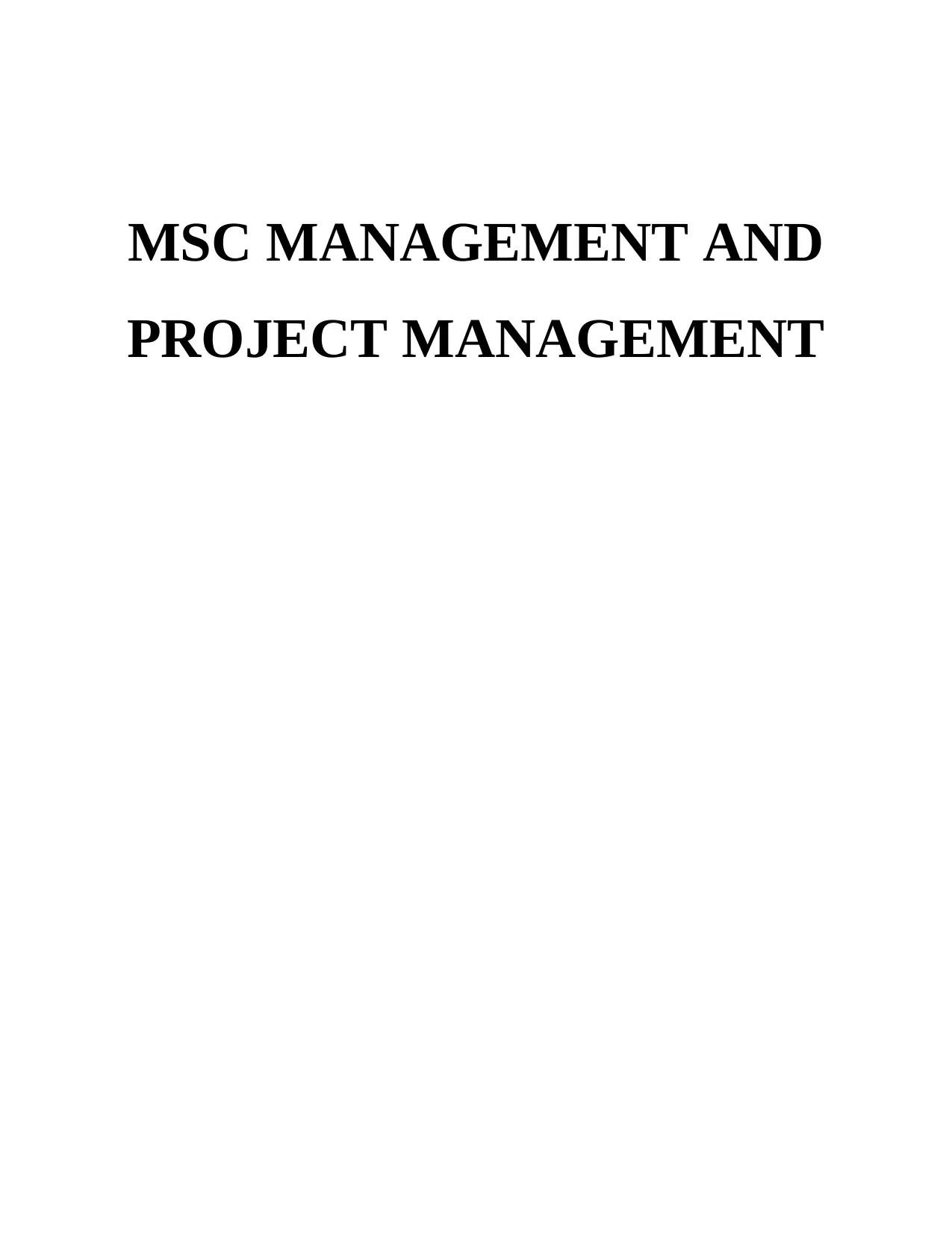
MSC MANAGEMENT AND
PROJECT MANAGEMENT
PROJECT MANAGEMENT
Paraphrase This Document
Need a fresh take? Get an instant paraphrase of this document with our AI Paraphraser
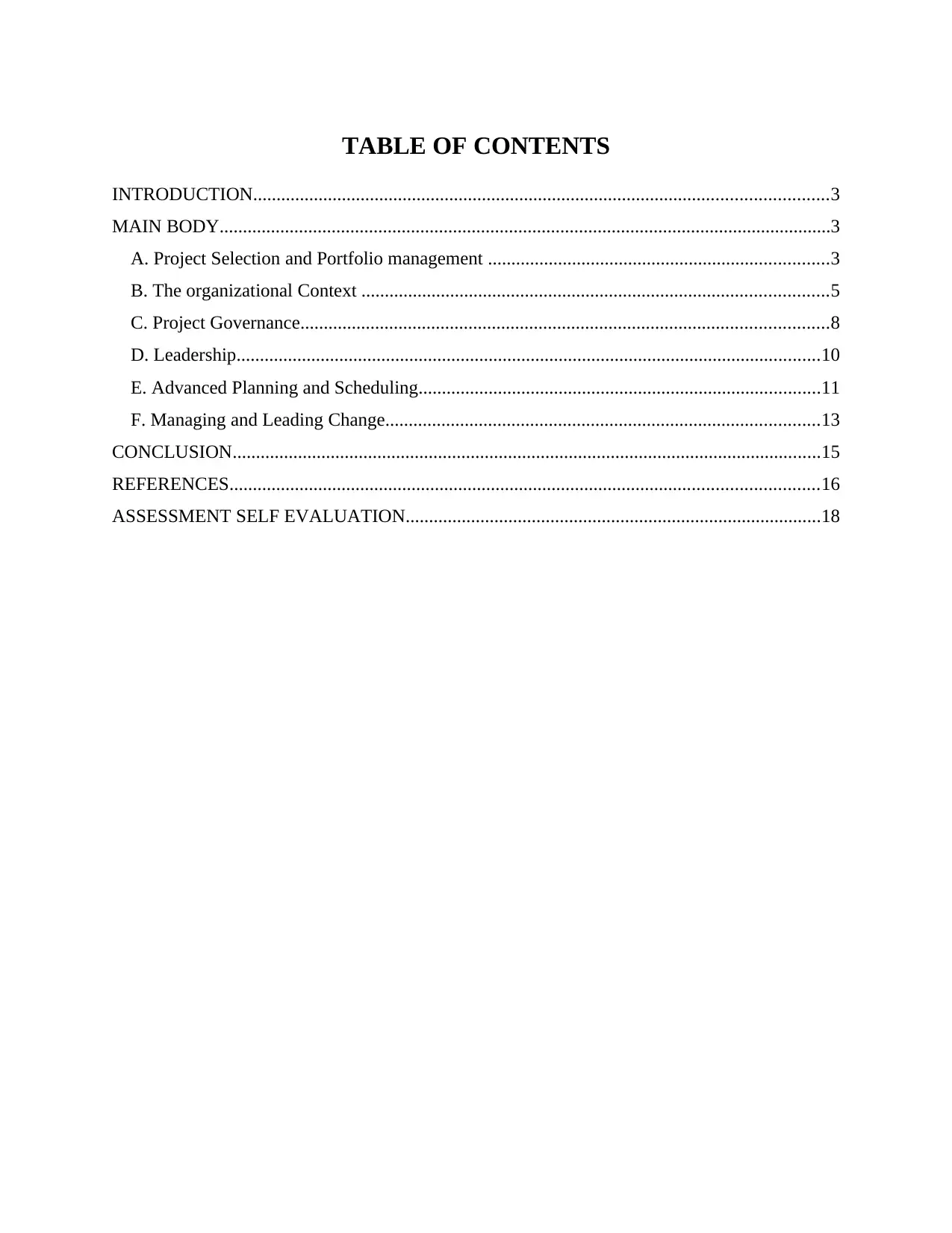
TABLE OF CONTENTS
INTRODUCTION...........................................................................................................................3
MAIN BODY...................................................................................................................................3
A. Project Selection and Portfolio management .........................................................................3
B. The organizational Context ....................................................................................................5
C. Project Governance.................................................................................................................8
D. Leadership.............................................................................................................................10
E. Advanced Planning and Scheduling......................................................................................11
F. Managing and Leading Change.............................................................................................13
CONCLUSION..............................................................................................................................15
REFERENCES..............................................................................................................................16
ASSESSMENT SELF EVALUATION.........................................................................................18
INTRODUCTION...........................................................................................................................3
MAIN BODY...................................................................................................................................3
A. Project Selection and Portfolio management .........................................................................3
B. The organizational Context ....................................................................................................5
C. Project Governance.................................................................................................................8
D. Leadership.............................................................................................................................10
E. Advanced Planning and Scheduling......................................................................................11
F. Managing and Leading Change.............................................................................................13
CONCLUSION..............................................................................................................................15
REFERENCES..............................................................................................................................16
ASSESSMENT SELF EVALUATION.........................................................................................18
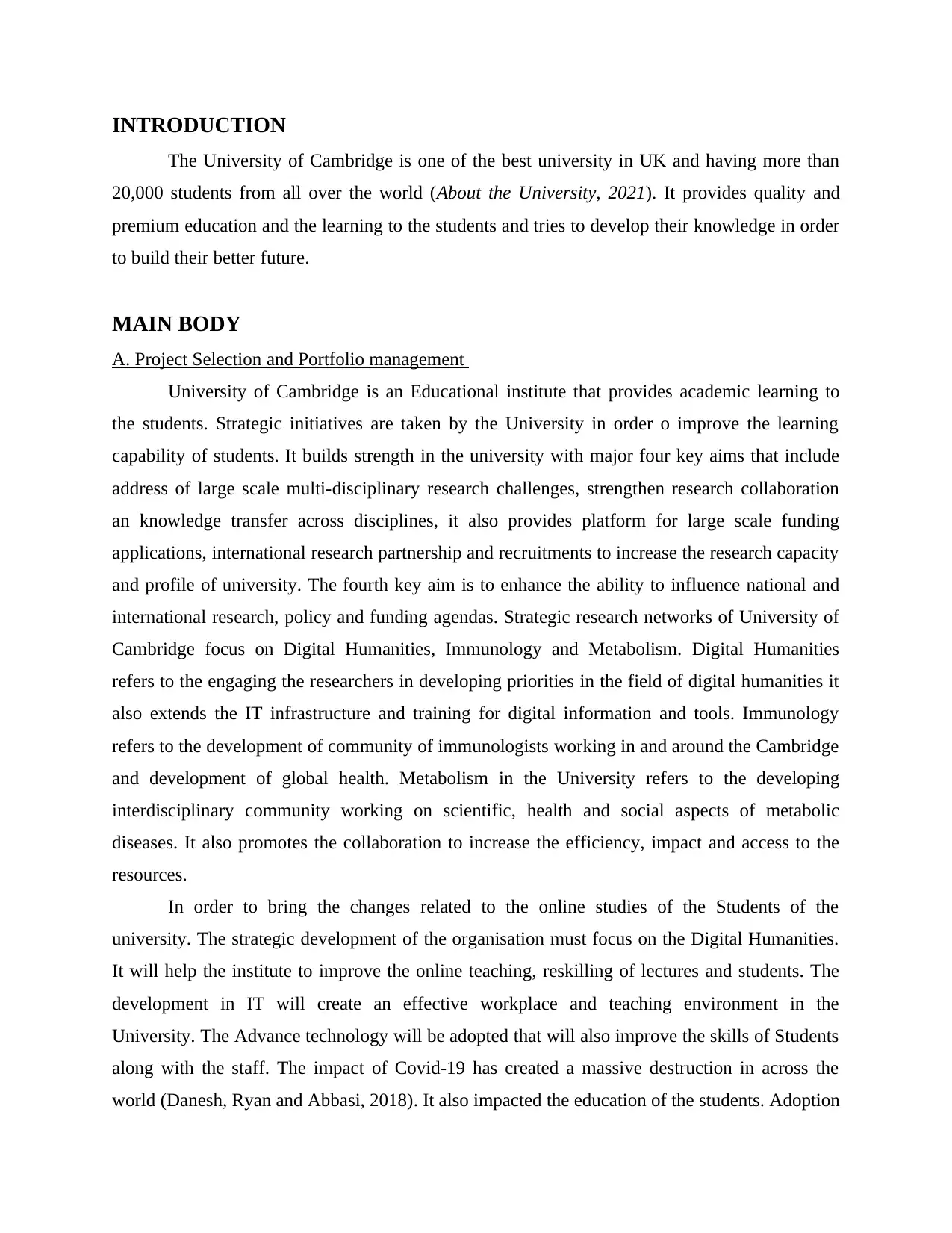
INTRODUCTION
The University of Cambridge is one of the best university in UK and having more than
20,000 students from all over the world (About the University, 2021). It provides quality and
premium education and the learning to the students and tries to develop their knowledge in order
to build their better future.
MAIN BODY
A. Project Selection and Portfolio management
University of Cambridge is an Educational institute that provides academic learning to
the students. Strategic initiatives are taken by the University in order o improve the learning
capability of students. It builds strength in the university with major four key aims that include
address of large scale multi-disciplinary research challenges, strengthen research collaboration
an knowledge transfer across disciplines, it also provides platform for large scale funding
applications, international research partnership and recruitments to increase the research capacity
and profile of university. The fourth key aim is to enhance the ability to influence national and
international research, policy and funding agendas. Strategic research networks of University of
Cambridge focus on Digital Humanities, Immunology and Metabolism. Digital Humanities
refers to the engaging the researchers in developing priorities in the field of digital humanities it
also extends the IT infrastructure and training for digital information and tools. Immunology
refers to the development of community of immunologists working in and around the Cambridge
and development of global health. Metabolism in the University refers to the developing
interdisciplinary community working on scientific, health and social aspects of metabolic
diseases. It also promotes the collaboration to increase the efficiency, impact and access to the
resources.
In order to bring the changes related to the online studies of the Students of the
university. The strategic development of the organisation must focus on the Digital Humanities.
It will help the institute to improve the online teaching, reskilling of lectures and students. The
development in IT will create an effective workplace and teaching environment in the
University. The Advance technology will be adopted that will also improve the skills of Students
along with the staff. The impact of Covid-19 has created a massive destruction in across the
world (Danesh, Ryan and Abbasi, 2018). It also impacted the education of the students. Adoption
The University of Cambridge is one of the best university in UK and having more than
20,000 students from all over the world (About the University, 2021). It provides quality and
premium education and the learning to the students and tries to develop their knowledge in order
to build their better future.
MAIN BODY
A. Project Selection and Portfolio management
University of Cambridge is an Educational institute that provides academic learning to
the students. Strategic initiatives are taken by the University in order o improve the learning
capability of students. It builds strength in the university with major four key aims that include
address of large scale multi-disciplinary research challenges, strengthen research collaboration
an knowledge transfer across disciplines, it also provides platform for large scale funding
applications, international research partnership and recruitments to increase the research capacity
and profile of university. The fourth key aim is to enhance the ability to influence national and
international research, policy and funding agendas. Strategic research networks of University of
Cambridge focus on Digital Humanities, Immunology and Metabolism. Digital Humanities
refers to the engaging the researchers in developing priorities in the field of digital humanities it
also extends the IT infrastructure and training for digital information and tools. Immunology
refers to the development of community of immunologists working in and around the Cambridge
and development of global health. Metabolism in the University refers to the developing
interdisciplinary community working on scientific, health and social aspects of metabolic
diseases. It also promotes the collaboration to increase the efficiency, impact and access to the
resources.
In order to bring the changes related to the online studies of the Students of the
university. The strategic development of the organisation must focus on the Digital Humanities.
It will help the institute to improve the online teaching, reskilling of lectures and students. The
development in IT will create an effective workplace and teaching environment in the
University. The Advance technology will be adopted that will also improve the skills of Students
along with the staff. The impact of Covid-19 has created a massive destruction in across the
world (Danesh, Ryan and Abbasi, 2018). It also impacted the education of the students. Adoption
⊘ This is a preview!⊘
Do you want full access?
Subscribe today to unlock all pages.

Trusted by 1+ million students worldwide
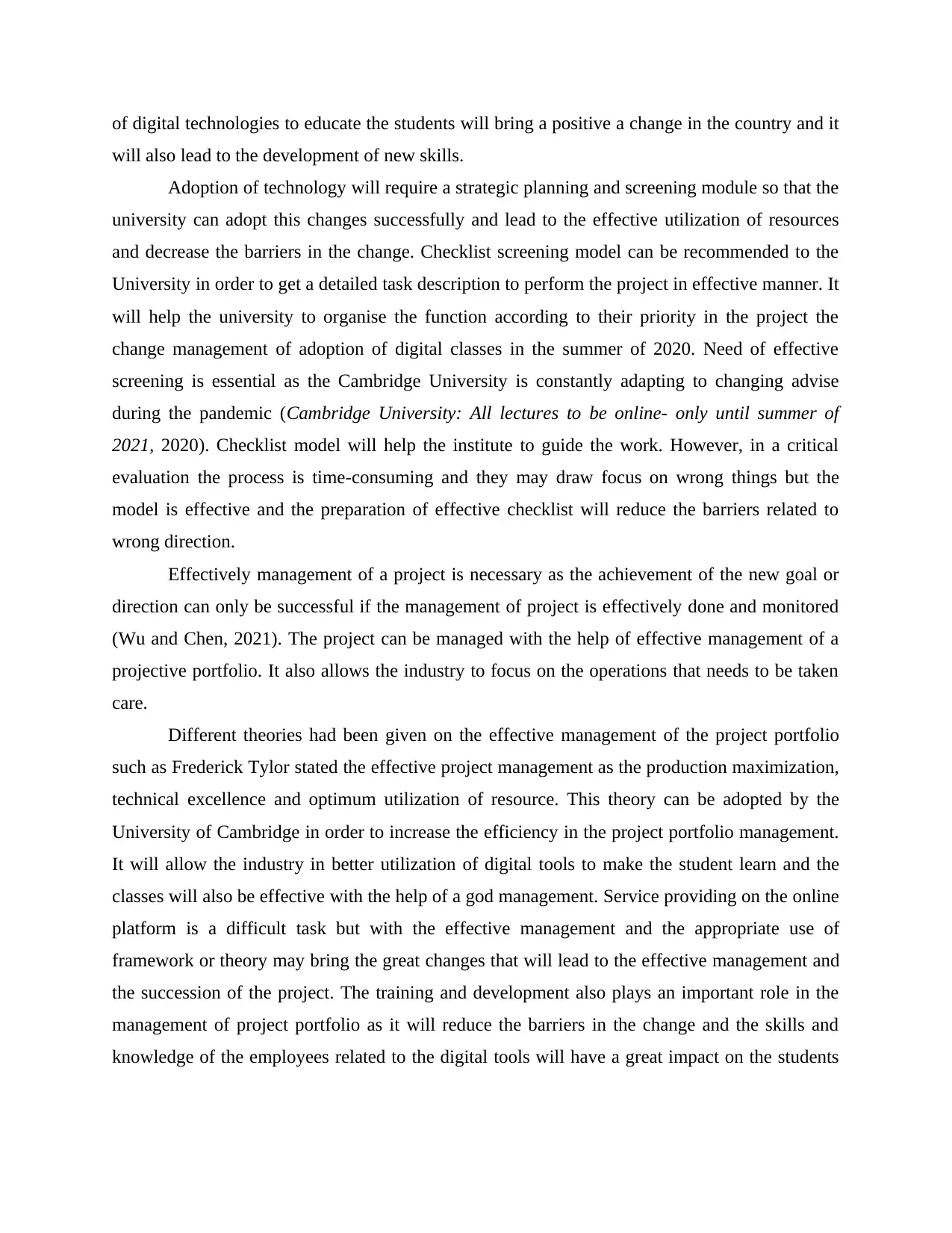
of digital technologies to educate the students will bring a positive a change in the country and it
will also lead to the development of new skills.
Adoption of technology will require a strategic planning and screening module so that the
university can adopt this changes successfully and lead to the effective utilization of resources
and decrease the barriers in the change. Checklist screening model can be recommended to the
University in order to get a detailed task description to perform the project in effective manner. It
will help the university to organise the function according to their priority in the project the
change management of adoption of digital classes in the summer of 2020. Need of effective
screening is essential as the Cambridge University is constantly adapting to changing advise
during the pandemic (Cambridge University: All lectures to be online- only until summer of
2021, 2020). Checklist model will help the institute to guide the work. However, in a critical
evaluation the process is time-consuming and they may draw focus on wrong things but the
model is effective and the preparation of effective checklist will reduce the barriers related to
wrong direction.
Effectively management of a project is necessary as the achievement of the new goal or
direction can only be successful if the management of project is effectively done and monitored
(Wu and Chen, 2021). The project can be managed with the help of effective management of a
projective portfolio. It also allows the industry to focus on the operations that needs to be taken
care.
Different theories had been given on the effective management of the project portfolio
such as Frederick Tylor stated the effective project management as the production maximization,
technical excellence and optimum utilization of resource. This theory can be adopted by the
University of Cambridge in order to increase the efficiency in the project portfolio management.
It will allow the industry in better utilization of digital tools to make the student learn and the
classes will also be effective with the help of a god management. Service providing on the online
platform is a difficult task but with the effective management and the appropriate use of
framework or theory may bring the great changes that will lead to the effective management and
the succession of the project. The training and development also plays an important role in the
management of project portfolio as it will reduce the barriers in the change and the skills and
knowledge of the employees related to the digital tools will have a great impact on the students
will also lead to the development of new skills.
Adoption of technology will require a strategic planning and screening module so that the
university can adopt this changes successfully and lead to the effective utilization of resources
and decrease the barriers in the change. Checklist screening model can be recommended to the
University in order to get a detailed task description to perform the project in effective manner. It
will help the university to organise the function according to their priority in the project the
change management of adoption of digital classes in the summer of 2020. Need of effective
screening is essential as the Cambridge University is constantly adapting to changing advise
during the pandemic (Cambridge University: All lectures to be online- only until summer of
2021, 2020). Checklist model will help the institute to guide the work. However, in a critical
evaluation the process is time-consuming and they may draw focus on wrong things but the
model is effective and the preparation of effective checklist will reduce the barriers related to
wrong direction.
Effectively management of a project is necessary as the achievement of the new goal or
direction can only be successful if the management of project is effectively done and monitored
(Wu and Chen, 2021). The project can be managed with the help of effective management of a
projective portfolio. It also allows the industry to focus on the operations that needs to be taken
care.
Different theories had been given on the effective management of the project portfolio
such as Frederick Tylor stated the effective project management as the production maximization,
technical excellence and optimum utilization of resource. This theory can be adopted by the
University of Cambridge in order to increase the efficiency in the project portfolio management.
It will allow the industry in better utilization of digital tools to make the student learn and the
classes will also be effective with the help of a god management. Service providing on the online
platform is a difficult task but with the effective management and the appropriate use of
framework or theory may bring the great changes that will lead to the effective management and
the succession of the project. The training and development also plays an important role in the
management of project portfolio as it will reduce the barriers in the change and the skills and
knowledge of the employees related to the digital tools will have a great impact on the students
Paraphrase This Document
Need a fresh take? Get an instant paraphrase of this document with our AI Paraphraser
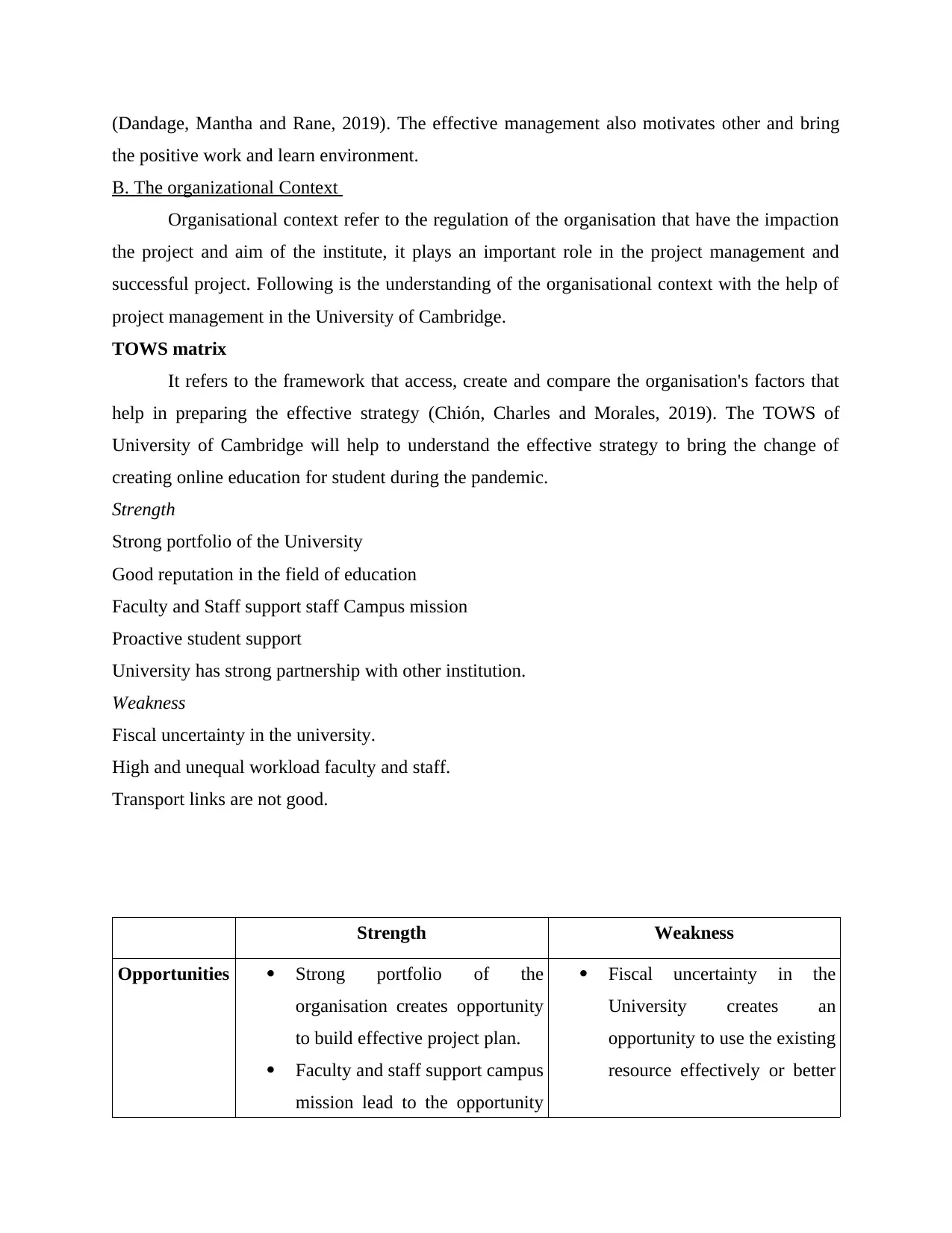
(Dandage, Mantha and Rane, 2019). The effective management also motivates other and bring
the positive work and learn environment.
B. The organizational Context
Organisational context refer to the regulation of the organisation that have the impaction
the project and aim of the institute, it plays an important role in the project management and
successful project. Following is the understanding of the organisational context with the help of
project management in the University of Cambridge.
TOWS matrix
It refers to the framework that access, create and compare the organisation's factors that
help in preparing the effective strategy (Chión, Charles and Morales, 2019). The TOWS of
University of Cambridge will help to understand the effective strategy to bring the change of
creating online education for student during the pandemic.
Strength
Strong portfolio of the University
Good reputation in the field of education
Faculty and Staff support staff Campus mission
Proactive student support
University has strong partnership with other institution.
Weakness
Fiscal uncertainty in the university.
High and unequal workload faculty and staff.
Transport links are not good.
Strength Weakness
Opportunities Strong portfolio of the
organisation creates opportunity
to build effective project plan.
Faculty and staff support campus
mission lead to the opportunity
Fiscal uncertainty in the
University creates an
opportunity to use the existing
resource effectively or better
the positive work and learn environment.
B. The organizational Context
Organisational context refer to the regulation of the organisation that have the impaction
the project and aim of the institute, it plays an important role in the project management and
successful project. Following is the understanding of the organisational context with the help of
project management in the University of Cambridge.
TOWS matrix
It refers to the framework that access, create and compare the organisation's factors that
help in preparing the effective strategy (Chión, Charles and Morales, 2019). The TOWS of
University of Cambridge will help to understand the effective strategy to bring the change of
creating online education for student during the pandemic.
Strength
Strong portfolio of the University
Good reputation in the field of education
Faculty and Staff support staff Campus mission
Proactive student support
University has strong partnership with other institution.
Weakness
Fiscal uncertainty in the university.
High and unequal workload faculty and staff.
Transport links are not good.
Strength Weakness
Opportunities Strong portfolio of the
organisation creates opportunity
to build effective project plan.
Faculty and staff support campus
mission lead to the opportunity
Fiscal uncertainty in the
University creates an
opportunity to use the existing
resource effectively or better
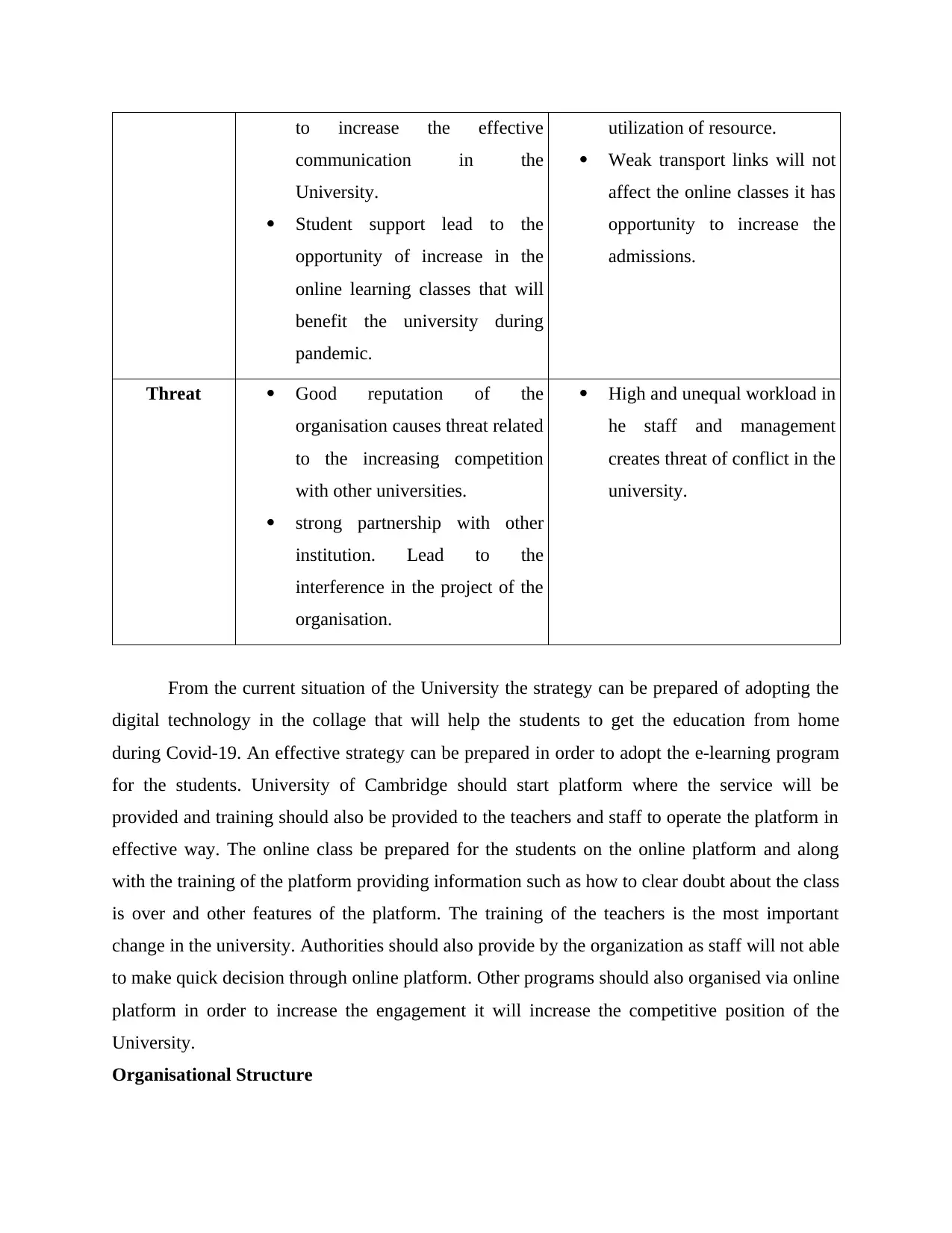
to increase the effective
communication in the
University.
Student support lead to the
opportunity of increase in the
online learning classes that will
benefit the university during
pandemic.
utilization of resource.
Weak transport links will not
affect the online classes it has
opportunity to increase the
admissions.
Threat Good reputation of the
organisation causes threat related
to the increasing competition
with other universities.
strong partnership with other
institution. Lead to the
interference in the project of the
organisation.
High and unequal workload in
he staff and management
creates threat of conflict in the
university.
From the current situation of the University the strategy can be prepared of adopting the
digital technology in the collage that will help the students to get the education from home
during Covid-19. An effective strategy can be prepared in order to adopt the e-learning program
for the students. University of Cambridge should start platform where the service will be
provided and training should also be provided to the teachers and staff to operate the platform in
effective way. The online class be prepared for the students on the online platform and along
with the training of the platform providing information such as how to clear doubt about the class
is over and other features of the platform. The training of the teachers is the most important
change in the university. Authorities should also provide by the organization as staff will not able
to make quick decision through online platform. Other programs should also organised via online
platform in order to increase the engagement it will increase the competitive position of the
University.
Organisational Structure
communication in the
University.
Student support lead to the
opportunity of increase in the
online learning classes that will
benefit the university during
pandemic.
utilization of resource.
Weak transport links will not
affect the online classes it has
opportunity to increase the
admissions.
Threat Good reputation of the
organisation causes threat related
to the increasing competition
with other universities.
strong partnership with other
institution. Lead to the
interference in the project of the
organisation.
High and unequal workload in
he staff and management
creates threat of conflict in the
university.
From the current situation of the University the strategy can be prepared of adopting the
digital technology in the collage that will help the students to get the education from home
during Covid-19. An effective strategy can be prepared in order to adopt the e-learning program
for the students. University of Cambridge should start platform where the service will be
provided and training should also be provided to the teachers and staff to operate the platform in
effective way. The online class be prepared for the students on the online platform and along
with the training of the platform providing information such as how to clear doubt about the class
is over and other features of the platform. The training of the teachers is the most important
change in the university. Authorities should also provide by the organization as staff will not able
to make quick decision through online platform. Other programs should also organised via online
platform in order to increase the engagement it will increase the competitive position of the
University.
Organisational Structure
⊘ This is a preview!⊘
Do you want full access?
Subscribe today to unlock all pages.

Trusted by 1+ million students worldwide
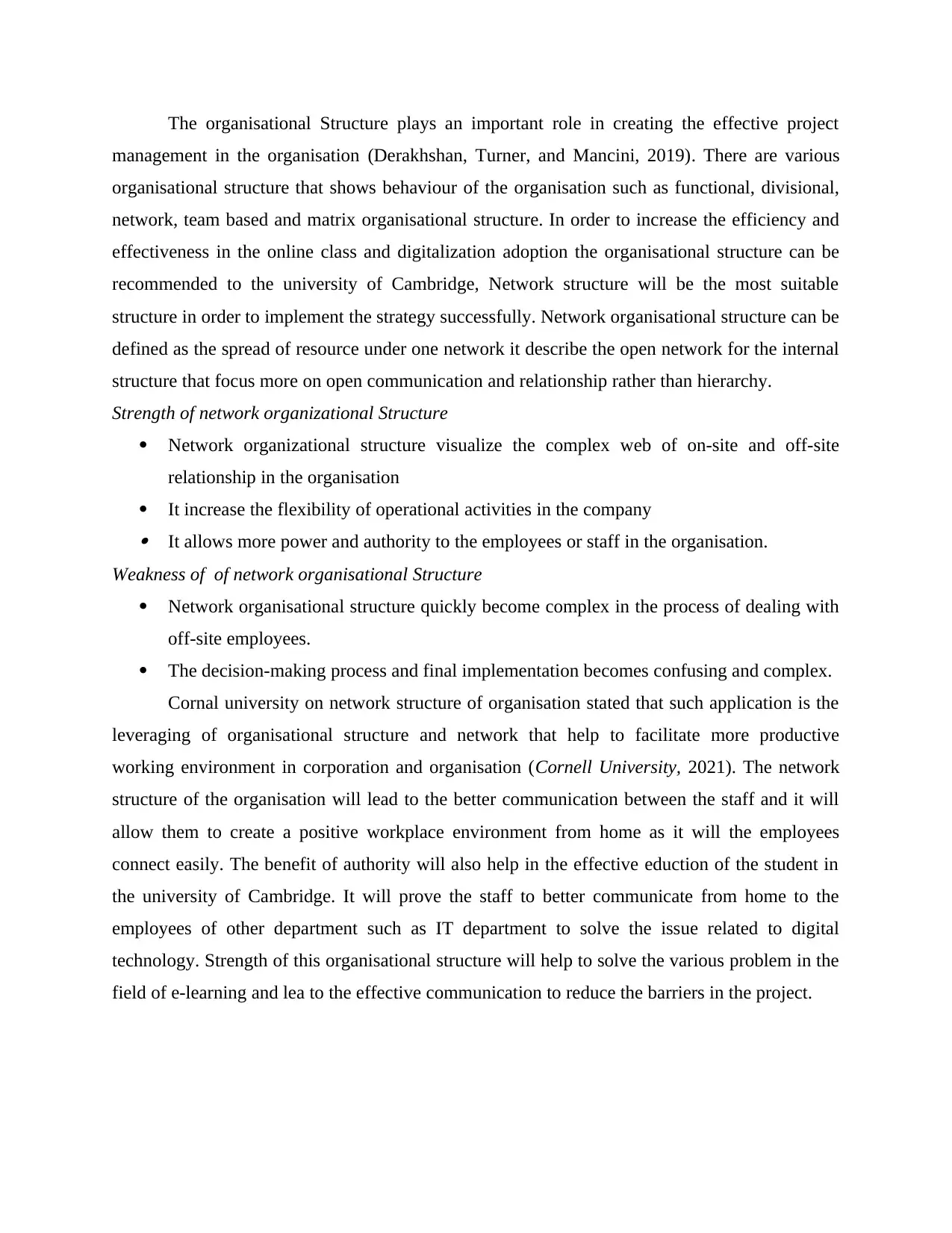
The organisational Structure plays an important role in creating the effective project
management in the organisation (Derakhshan, Turner, and Mancini, 2019). There are various
organisational structure that shows behaviour of the organisation such as functional, divisional,
network, team based and matrix organisational structure. In order to increase the efficiency and
effectiveness in the online class and digitalization adoption the organisational structure can be
recommended to the university of Cambridge, Network structure will be the most suitable
structure in order to implement the strategy successfully. Network organisational structure can be
defined as the spread of resource under one network it describe the open network for the internal
structure that focus more on open communication and relationship rather than hierarchy.
Strength of network organizational Structure
Network organizational structure visualize the complex web of on-site and off-site
relationship in the organisation
It increase the flexibility of operational activities in the company It allows more power and authority to the employees or staff in the organisation.
Weakness of of network organisational Structure
Network organisational structure quickly become complex in the process of dealing with
off-site employees.
The decision-making process and final implementation becomes confusing and complex.
Cornal university on network structure of organisation stated that such application is the
leveraging of organisational structure and network that help to facilitate more productive
working environment in corporation and organisation (Cornell University, 2021). The network
structure of the organisation will lead to the better communication between the staff and it will
allow them to create a positive workplace environment from home as it will the employees
connect easily. The benefit of authority will also help in the effective eduction of the student in
the university of Cambridge. It will prove the staff to better communicate from home to the
employees of other department such as IT department to solve the issue related to digital
technology. Strength of this organisational structure will help to solve the various problem in the
field of e-learning and lea to the effective communication to reduce the barriers in the project.
management in the organisation (Derakhshan, Turner, and Mancini, 2019). There are various
organisational structure that shows behaviour of the organisation such as functional, divisional,
network, team based and matrix organisational structure. In order to increase the efficiency and
effectiveness in the online class and digitalization adoption the organisational structure can be
recommended to the university of Cambridge, Network structure will be the most suitable
structure in order to implement the strategy successfully. Network organisational structure can be
defined as the spread of resource under one network it describe the open network for the internal
structure that focus more on open communication and relationship rather than hierarchy.
Strength of network organizational Structure
Network organizational structure visualize the complex web of on-site and off-site
relationship in the organisation
It increase the flexibility of operational activities in the company It allows more power and authority to the employees or staff in the organisation.
Weakness of of network organisational Structure
Network organisational structure quickly become complex in the process of dealing with
off-site employees.
The decision-making process and final implementation becomes confusing and complex.
Cornal university on network structure of organisation stated that such application is the
leveraging of organisational structure and network that help to facilitate more productive
working environment in corporation and organisation (Cornell University, 2021). The network
structure of the organisation will lead to the better communication between the staff and it will
allow them to create a positive workplace environment from home as it will the employees
connect easily. The benefit of authority will also help in the effective eduction of the student in
the university of Cambridge. It will prove the staff to better communicate from home to the
employees of other department such as IT department to solve the issue related to digital
technology. Strength of this organisational structure will help to solve the various problem in the
field of e-learning and lea to the effective communication to reduce the barriers in the project.
Paraphrase This Document
Need a fresh take? Get an instant paraphrase of this document with our AI Paraphraser
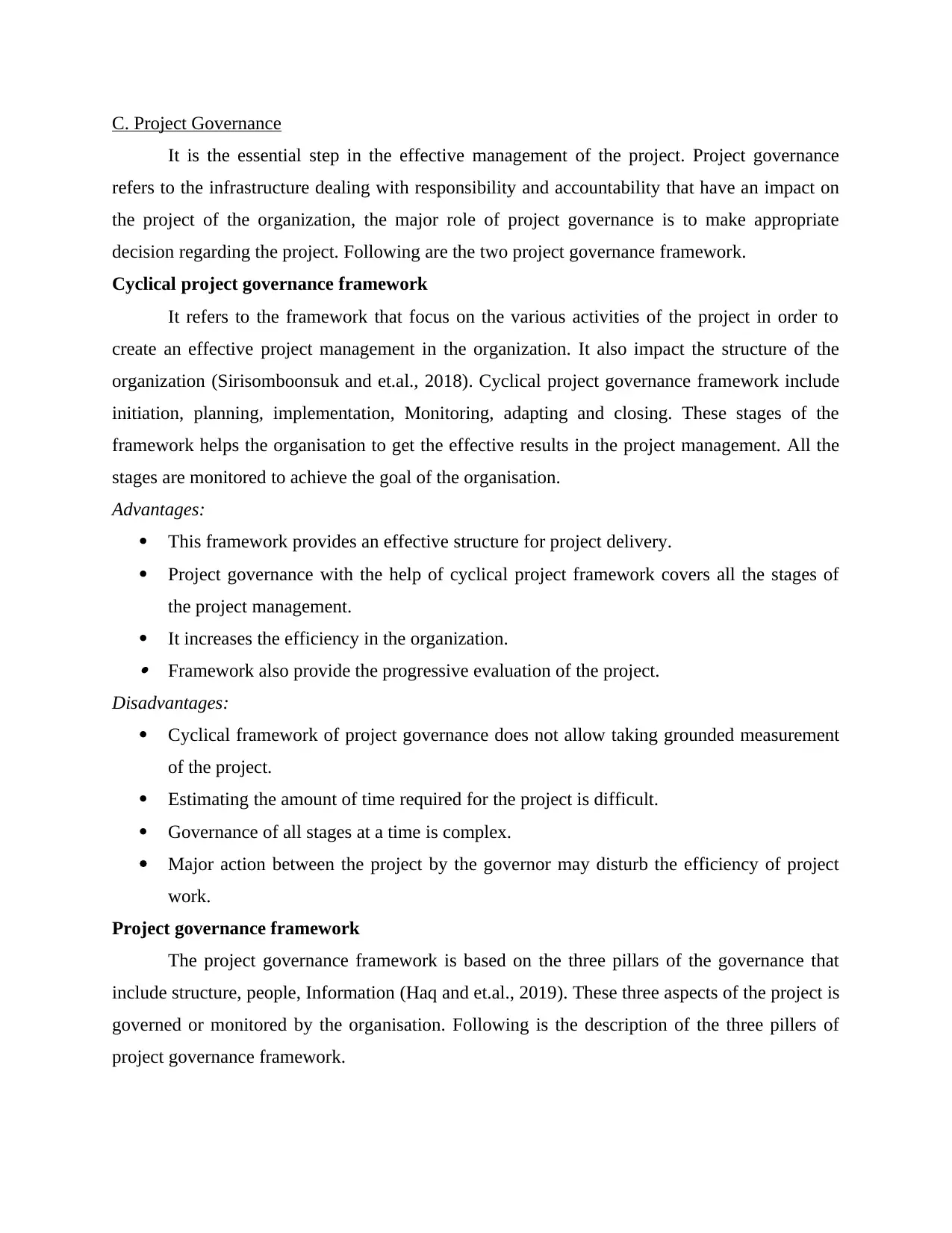
C. Project Governance
It is the essential step in the effective management of the project. Project governance
refers to the infrastructure dealing with responsibility and accountability that have an impact on
the project of the organization, the major role of project governance is to make appropriate
decision regarding the project. Following are the two project governance framework.
Cyclical project governance framework
It refers to the framework that focus on the various activities of the project in order to
create an effective project management in the organization. It also impact the structure of the
organization (Sirisomboonsuk and et.al., 2018). Cyclical project governance framework include
initiation, planning, implementation, Monitoring, adapting and closing. These stages of the
framework helps the organisation to get the effective results in the project management. All the
stages are monitored to achieve the goal of the organisation.
Advantages:
This framework provides an effective structure for project delivery.
Project governance with the help of cyclical project framework covers all the stages of
the project management.
It increases the efficiency in the organization. Framework also provide the progressive evaluation of the project.
Disadvantages:
Cyclical framework of project governance does not allow taking grounded measurement
of the project.
Estimating the amount of time required for the project is difficult.
Governance of all stages at a time is complex.
Major action between the project by the governor may disturb the efficiency of project
work.
Project governance framework
The project governance framework is based on the three pillars of the governance that
include structure, people, Information (Haq and et.al., 2019). These three aspects of the project is
governed or monitored by the organisation. Following is the description of the three pillers of
project governance framework.
It is the essential step in the effective management of the project. Project governance
refers to the infrastructure dealing with responsibility and accountability that have an impact on
the project of the organization, the major role of project governance is to make appropriate
decision regarding the project. Following are the two project governance framework.
Cyclical project governance framework
It refers to the framework that focus on the various activities of the project in order to
create an effective project management in the organization. It also impact the structure of the
organization (Sirisomboonsuk and et.al., 2018). Cyclical project governance framework include
initiation, planning, implementation, Monitoring, adapting and closing. These stages of the
framework helps the organisation to get the effective results in the project management. All the
stages are monitored to achieve the goal of the organisation.
Advantages:
This framework provides an effective structure for project delivery.
Project governance with the help of cyclical project framework covers all the stages of
the project management.
It increases the efficiency in the organization. Framework also provide the progressive evaluation of the project.
Disadvantages:
Cyclical framework of project governance does not allow taking grounded measurement
of the project.
Estimating the amount of time required for the project is difficult.
Governance of all stages at a time is complex.
Major action between the project by the governor may disturb the efficiency of project
work.
Project governance framework
The project governance framework is based on the three pillars of the governance that
include structure, people, Information (Haq and et.al., 2019). These three aspects of the project is
governed or monitored by the organisation. Following is the description of the three pillers of
project governance framework.
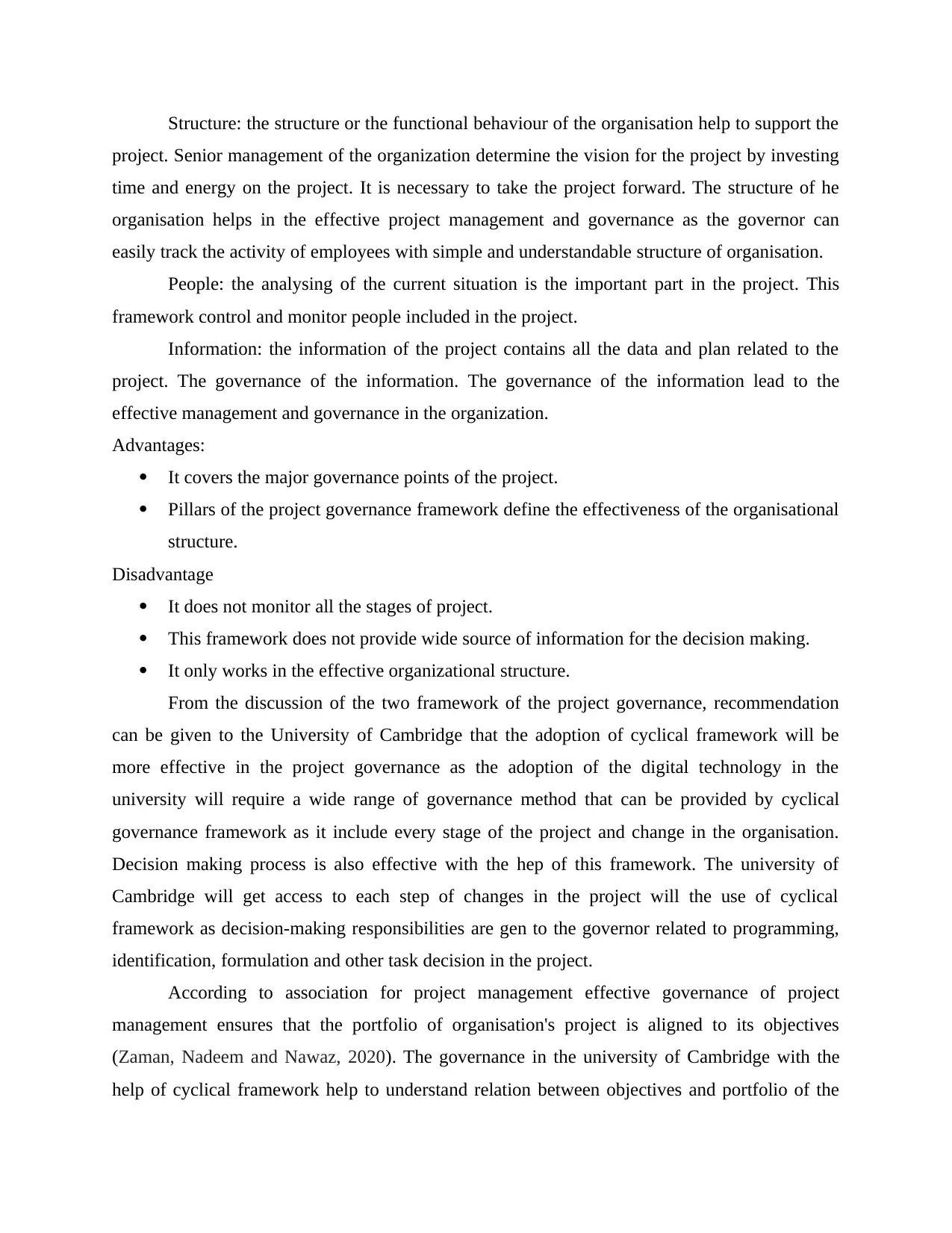
Structure: the structure or the functional behaviour of the organisation help to support the
project. Senior management of the organization determine the vision for the project by investing
time and energy on the project. It is necessary to take the project forward. The structure of he
organisation helps in the effective project management and governance as the governor can
easily track the activity of employees with simple and understandable structure of organisation.
People: the analysing of the current situation is the important part in the project. This
framework control and monitor people included in the project.
Information: the information of the project contains all the data and plan related to the
project. The governance of the information. The governance of the information lead to the
effective management and governance in the organization.
Advantages:
It covers the major governance points of the project.
Pillars of the project governance framework define the effectiveness of the organisational
structure.
Disadvantage
It does not monitor all the stages of project.
This framework does not provide wide source of information for the decision making.
It only works in the effective organizational structure.
From the discussion of the two framework of the project governance, recommendation
can be given to the University of Cambridge that the adoption of cyclical framework will be
more effective in the project governance as the adoption of the digital technology in the
university will require a wide range of governance method that can be provided by cyclical
governance framework as it include every stage of the project and change in the organisation.
Decision making process is also effective with the hep of this framework. The university of
Cambridge will get access to each step of changes in the project will the use of cyclical
framework as decision-making responsibilities are gen to the governor related to programming,
identification, formulation and other task decision in the project.
According to association for project management effective governance of project
management ensures that the portfolio of organisation's project is aligned to its objectives
(Zaman, Nadeem and Nawaz, 2020). The governance in the university of Cambridge with the
help of cyclical framework help to understand relation between objectives and portfolio of the
project. Senior management of the organization determine the vision for the project by investing
time and energy on the project. It is necessary to take the project forward. The structure of he
organisation helps in the effective project management and governance as the governor can
easily track the activity of employees with simple and understandable structure of organisation.
People: the analysing of the current situation is the important part in the project. This
framework control and monitor people included in the project.
Information: the information of the project contains all the data and plan related to the
project. The governance of the information. The governance of the information lead to the
effective management and governance in the organization.
Advantages:
It covers the major governance points of the project.
Pillars of the project governance framework define the effectiveness of the organisational
structure.
Disadvantage
It does not monitor all the stages of project.
This framework does not provide wide source of information for the decision making.
It only works in the effective organizational structure.
From the discussion of the two framework of the project governance, recommendation
can be given to the University of Cambridge that the adoption of cyclical framework will be
more effective in the project governance as the adoption of the digital technology in the
university will require a wide range of governance method that can be provided by cyclical
governance framework as it include every stage of the project and change in the organisation.
Decision making process is also effective with the hep of this framework. The university of
Cambridge will get access to each step of changes in the project will the use of cyclical
framework as decision-making responsibilities are gen to the governor related to programming,
identification, formulation and other task decision in the project.
According to association for project management effective governance of project
management ensures that the portfolio of organisation's project is aligned to its objectives
(Zaman, Nadeem and Nawaz, 2020). The governance in the university of Cambridge with the
help of cyclical framework help to understand relation between objectives and portfolio of the
⊘ This is a preview!⊘
Do you want full access?
Subscribe today to unlock all pages.

Trusted by 1+ million students worldwide
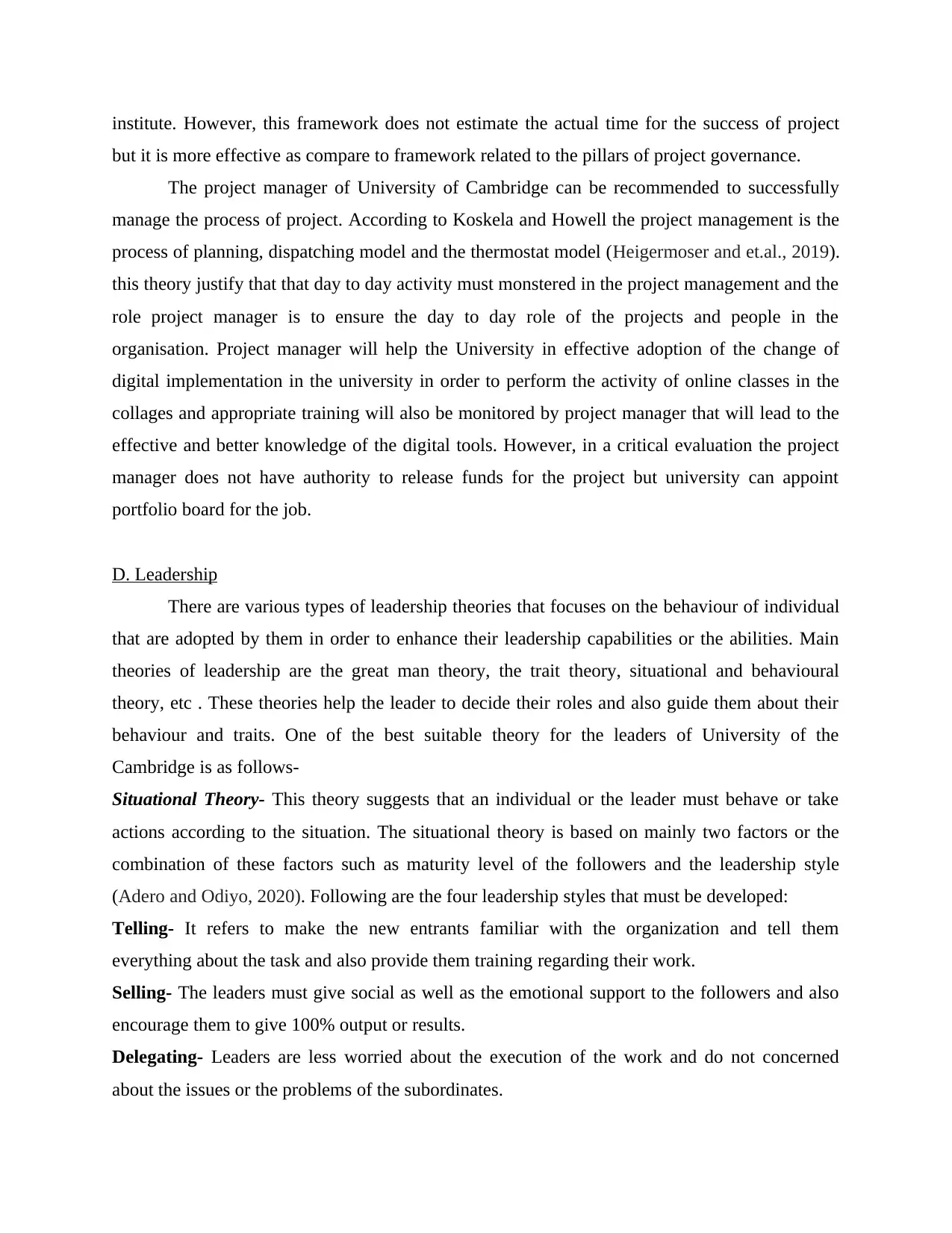
institute. However, this framework does not estimate the actual time for the success of project
but it is more effective as compare to framework related to the pillars of project governance.
The project manager of University of Cambridge can be recommended to successfully
manage the process of project. According to Koskela and Howell the project management is the
process of planning, dispatching model and the thermostat model (Heigermoser and et.al., 2019).
this theory justify that that day to day activity must monstered in the project management and the
role project manager is to ensure the day to day role of the projects and people in the
organisation. Project manager will help the University in effective adoption of the change of
digital implementation in the university in order to perform the activity of online classes in the
collages and appropriate training will also be monitored by project manager that will lead to the
effective and better knowledge of the digital tools. However, in a critical evaluation the project
manager does not have authority to release funds for the project but university can appoint
portfolio board for the job.
D. Leadership
There are various types of leadership theories that focuses on the behaviour of individual
that are adopted by them in order to enhance their leadership capabilities or the abilities. Main
theories of leadership are the great man theory, the trait theory, situational and behavioural
theory, etc . These theories help the leader to decide their roles and also guide them about their
behaviour and traits. One of the best suitable theory for the leaders of University of the
Cambridge is as follows-
Situational Theory- This theory suggests that an individual or the leader must behave or take
actions according to the situation. The situational theory is based on mainly two factors or the
combination of these factors such as maturity level of the followers and the leadership style
(Adero and Odiyo, 2020). Following are the four leadership styles that must be developed:
Telling- It refers to make the new entrants familiar with the organization and tell them
everything about the task and also provide them training regarding their work.
Selling- The leaders must give social as well as the emotional support to the followers and also
encourage them to give 100% output or results.
Delegating- Leaders are less worried about the execution of the work and do not concerned
about the issues or the problems of the subordinates.
but it is more effective as compare to framework related to the pillars of project governance.
The project manager of University of Cambridge can be recommended to successfully
manage the process of project. According to Koskela and Howell the project management is the
process of planning, dispatching model and the thermostat model (Heigermoser and et.al., 2019).
this theory justify that that day to day activity must monstered in the project management and the
role project manager is to ensure the day to day role of the projects and people in the
organisation. Project manager will help the University in effective adoption of the change of
digital implementation in the university in order to perform the activity of online classes in the
collages and appropriate training will also be monitored by project manager that will lead to the
effective and better knowledge of the digital tools. However, in a critical evaluation the project
manager does not have authority to release funds for the project but university can appoint
portfolio board for the job.
D. Leadership
There are various types of leadership theories that focuses on the behaviour of individual
that are adopted by them in order to enhance their leadership capabilities or the abilities. Main
theories of leadership are the great man theory, the trait theory, situational and behavioural
theory, etc . These theories help the leader to decide their roles and also guide them about their
behaviour and traits. One of the best suitable theory for the leaders of University of the
Cambridge is as follows-
Situational Theory- This theory suggests that an individual or the leader must behave or take
actions according to the situation. The situational theory is based on mainly two factors or the
combination of these factors such as maturity level of the followers and the leadership style
(Adero and Odiyo, 2020). Following are the four leadership styles that must be developed:
Telling- It refers to make the new entrants familiar with the organization and tell them
everything about the task and also provide them training regarding their work.
Selling- The leaders must give social as well as the emotional support to the followers and also
encourage them to give 100% output or results.
Delegating- Leaders are less worried about the execution of the work and do not concerned
about the issues or the problems of the subordinates.
Paraphrase This Document
Need a fresh take? Get an instant paraphrase of this document with our AI Paraphraser
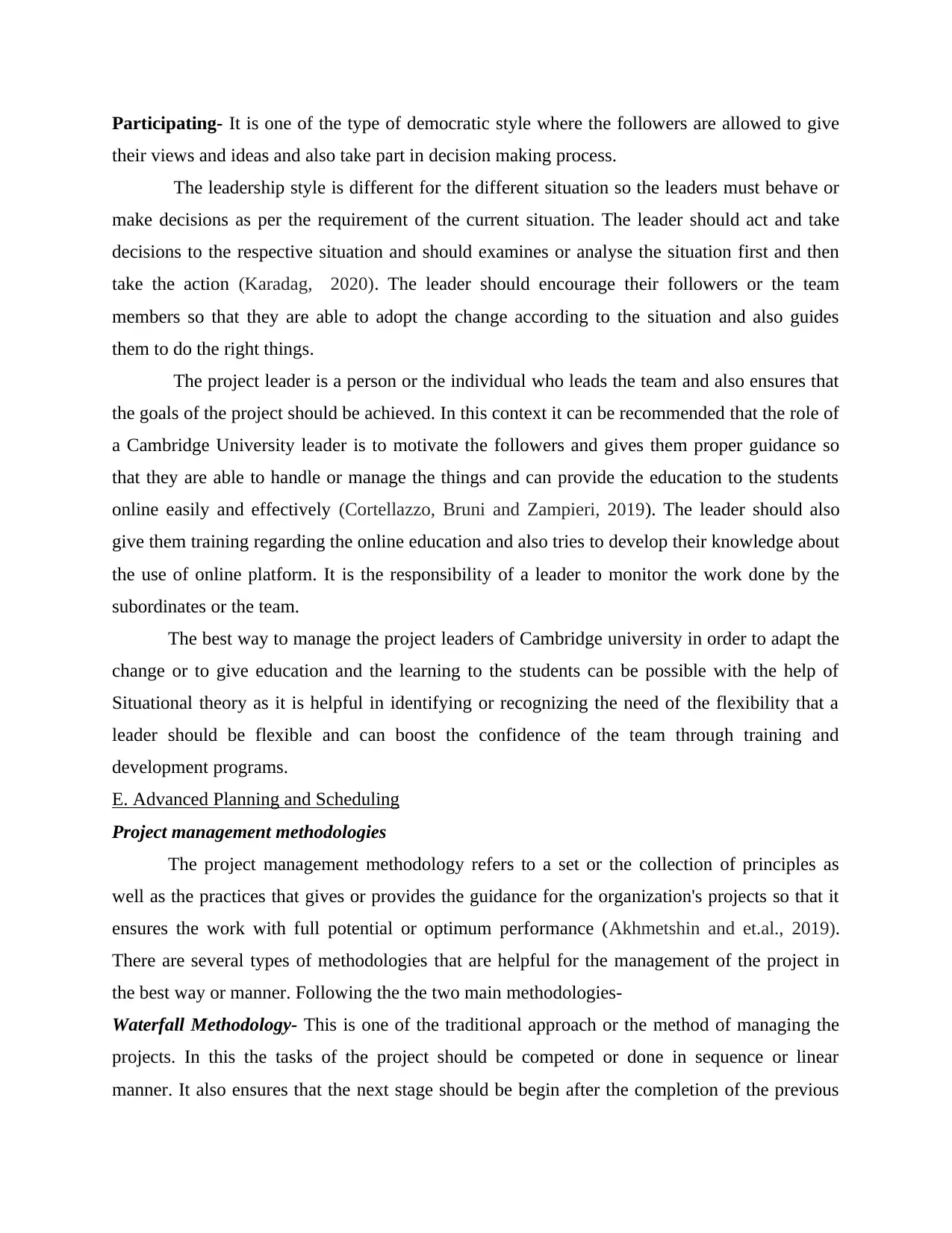
Participating- It is one of the type of democratic style where the followers are allowed to give
their views and ideas and also take part in decision making process.
The leadership style is different for the different situation so the leaders must behave or
make decisions as per the requirement of the current situation. The leader should act and take
decisions to the respective situation and should examines or analyse the situation first and then
take the action (Karadag, 2020). The leader should encourage their followers or the team
members so that they are able to adopt the change according to the situation and also guides
them to do the right things.
The project leader is a person or the individual who leads the team and also ensures that
the goals of the project should be achieved. In this context it can be recommended that the role of
a Cambridge University leader is to motivate the followers and gives them proper guidance so
that they are able to handle or manage the things and can provide the education to the students
online easily and effectively (Cortellazzo, Bruni and Zampieri, 2019). The leader should also
give them training regarding the online education and also tries to develop their knowledge about
the use of online platform. It is the responsibility of a leader to monitor the work done by the
subordinates or the team.
The best way to manage the project leaders of Cambridge university in order to adapt the
change or to give education and the learning to the students can be possible with the help of
Situational theory as it is helpful in identifying or recognizing the need of the flexibility that a
leader should be flexible and can boost the confidence of the team through training and
development programs.
E. Advanced Planning and Scheduling
Project management methodologies
The project management methodology refers to a set or the collection of principles as
well as the practices that gives or provides the guidance for the organization's projects so that it
ensures the work with full potential or optimum performance (Akhmetshin and et.al., 2019).
There are several types of methodologies that are helpful for the management of the project in
the best way or manner. Following the the two main methodologies-
Waterfall Methodology- This is one of the traditional approach or the method of managing the
projects. In this the tasks of the project should be competed or done in sequence or linear
manner. It also ensures that the next stage should be begin after the completion of the previous
their views and ideas and also take part in decision making process.
The leadership style is different for the different situation so the leaders must behave or
make decisions as per the requirement of the current situation. The leader should act and take
decisions to the respective situation and should examines or analyse the situation first and then
take the action (Karadag, 2020). The leader should encourage their followers or the team
members so that they are able to adopt the change according to the situation and also guides
them to do the right things.
The project leader is a person or the individual who leads the team and also ensures that
the goals of the project should be achieved. In this context it can be recommended that the role of
a Cambridge University leader is to motivate the followers and gives them proper guidance so
that they are able to handle or manage the things and can provide the education to the students
online easily and effectively (Cortellazzo, Bruni and Zampieri, 2019). The leader should also
give them training regarding the online education and also tries to develop their knowledge about
the use of online platform. It is the responsibility of a leader to monitor the work done by the
subordinates or the team.
The best way to manage the project leaders of Cambridge university in order to adapt the
change or to give education and the learning to the students can be possible with the help of
Situational theory as it is helpful in identifying or recognizing the need of the flexibility that a
leader should be flexible and can boost the confidence of the team through training and
development programs.
E. Advanced Planning and Scheduling
Project management methodologies
The project management methodology refers to a set or the collection of principles as
well as the practices that gives or provides the guidance for the organization's projects so that it
ensures the work with full potential or optimum performance (Akhmetshin and et.al., 2019).
There are several types of methodologies that are helpful for the management of the project in
the best way or manner. Following the the two main methodologies-
Waterfall Methodology- This is one of the traditional approach or the method of managing the
projects. In this the tasks of the project should be competed or done in sequence or linear
manner. It also ensures that the next stage should be begin after the completion of the previous
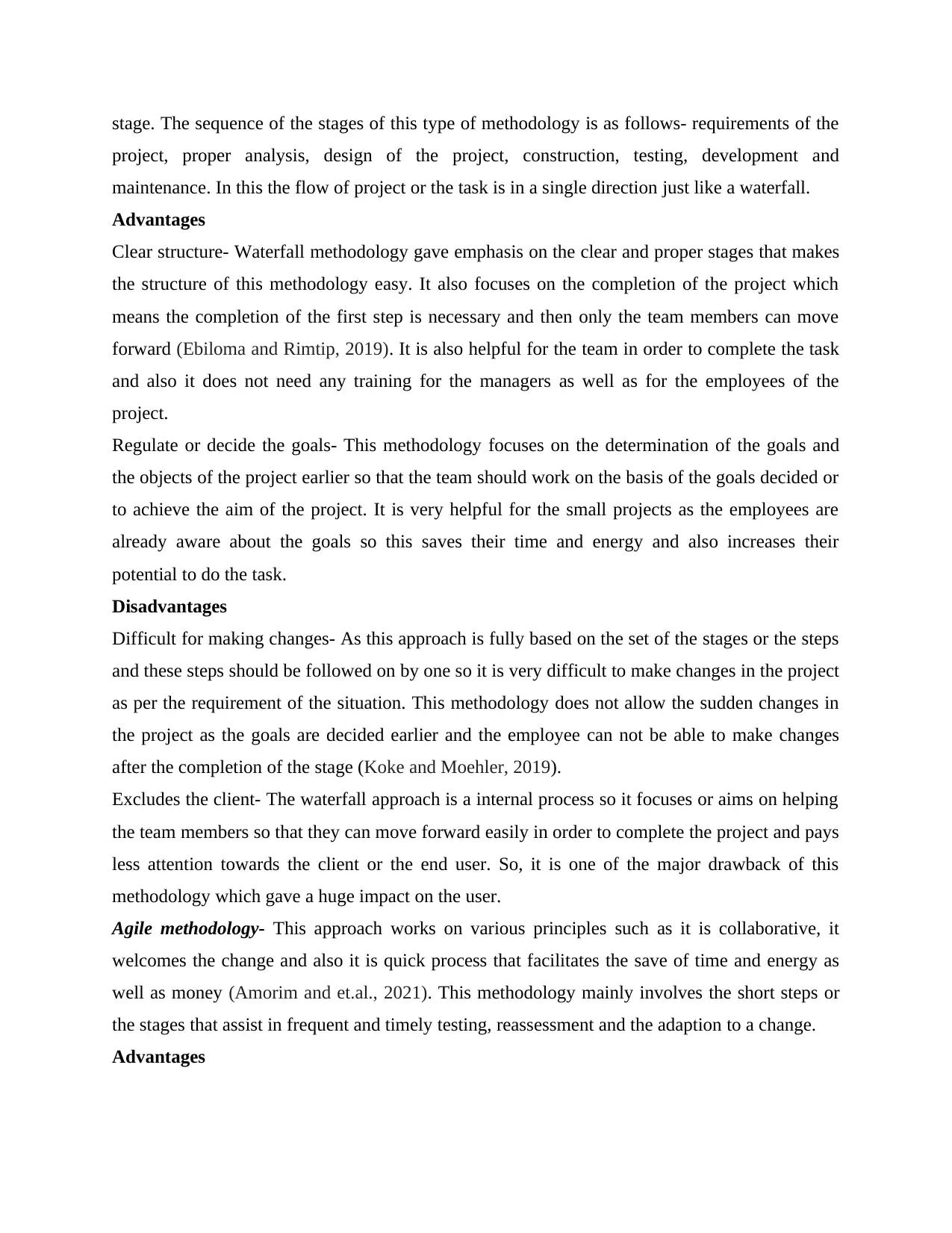
stage. The sequence of the stages of this type of methodology is as follows- requirements of the
project, proper analysis, design of the project, construction, testing, development and
maintenance. In this the flow of project or the task is in a single direction just like a waterfall.
Advantages
Clear structure- Waterfall methodology gave emphasis on the clear and proper stages that makes
the structure of this methodology easy. It also focuses on the completion of the project which
means the completion of the first step is necessary and then only the team members can move
forward (Ebiloma and Rimtip, 2019). It is also helpful for the team in order to complete the task
and also it does not need any training for the managers as well as for the employees of the
project.
Regulate or decide the goals- This methodology focuses on the determination of the goals and
the objects of the project earlier so that the team should work on the basis of the goals decided or
to achieve the aim of the project. It is very helpful for the small projects as the employees are
already aware about the goals so this saves their time and energy and also increases their
potential to do the task.
Disadvantages
Difficult for making changes- As this approach is fully based on the set of the stages or the steps
and these steps should be followed on by one so it is very difficult to make changes in the project
as per the requirement of the situation. This methodology does not allow the sudden changes in
the project as the goals are decided earlier and the employee can not be able to make changes
after the completion of the stage (Koke and Moehler, 2019).
Excludes the client- The waterfall approach is a internal process so it focuses or aims on helping
the team members so that they can move forward easily in order to complete the project and pays
less attention towards the client or the end user. So, it is one of the major drawback of this
methodology which gave a huge impact on the user.
Agile methodology- This approach works on various principles such as it is collaborative, it
welcomes the change and also it is quick process that facilitates the save of time and energy as
well as money (Amorim and et.al., 2021). This methodology mainly involves the short steps or
the stages that assist in frequent and timely testing, reassessment and the adaption to a change.
Advantages
project, proper analysis, design of the project, construction, testing, development and
maintenance. In this the flow of project or the task is in a single direction just like a waterfall.
Advantages
Clear structure- Waterfall methodology gave emphasis on the clear and proper stages that makes
the structure of this methodology easy. It also focuses on the completion of the project which
means the completion of the first step is necessary and then only the team members can move
forward (Ebiloma and Rimtip, 2019). It is also helpful for the team in order to complete the task
and also it does not need any training for the managers as well as for the employees of the
project.
Regulate or decide the goals- This methodology focuses on the determination of the goals and
the objects of the project earlier so that the team should work on the basis of the goals decided or
to achieve the aim of the project. It is very helpful for the small projects as the employees are
already aware about the goals so this saves their time and energy and also increases their
potential to do the task.
Disadvantages
Difficult for making changes- As this approach is fully based on the set of the stages or the steps
and these steps should be followed on by one so it is very difficult to make changes in the project
as per the requirement of the situation. This methodology does not allow the sudden changes in
the project as the goals are decided earlier and the employee can not be able to make changes
after the completion of the stage (Koke and Moehler, 2019).
Excludes the client- The waterfall approach is a internal process so it focuses or aims on helping
the team members so that they can move forward easily in order to complete the project and pays
less attention towards the client or the end user. So, it is one of the major drawback of this
methodology which gave a huge impact on the user.
Agile methodology- This approach works on various principles such as it is collaborative, it
welcomes the change and also it is quick process that facilitates the save of time and energy as
well as money (Amorim and et.al., 2021). This methodology mainly involves the short steps or
the stages that assist in frequent and timely testing, reassessment and the adaption to a change.
Advantages
⊘ This is a preview!⊘
Do you want full access?
Subscribe today to unlock all pages.

Trusted by 1+ million students worldwide
1 out of 18
Related Documents
Your All-in-One AI-Powered Toolkit for Academic Success.
+13062052269
info@desklib.com
Available 24*7 on WhatsApp / Email
![[object Object]](/_next/static/media/star-bottom.7253800d.svg)
Unlock your academic potential
Copyright © 2020–2025 A2Z Services. All Rights Reserved. Developed and managed by ZUCOL.





